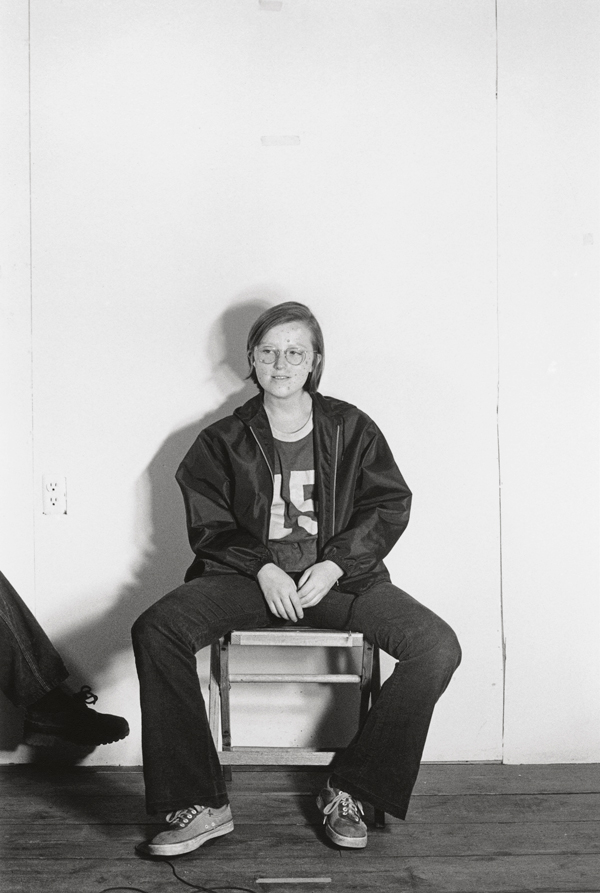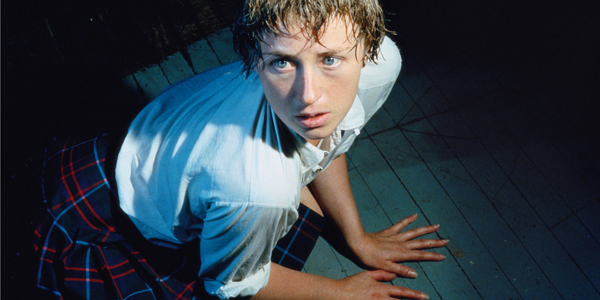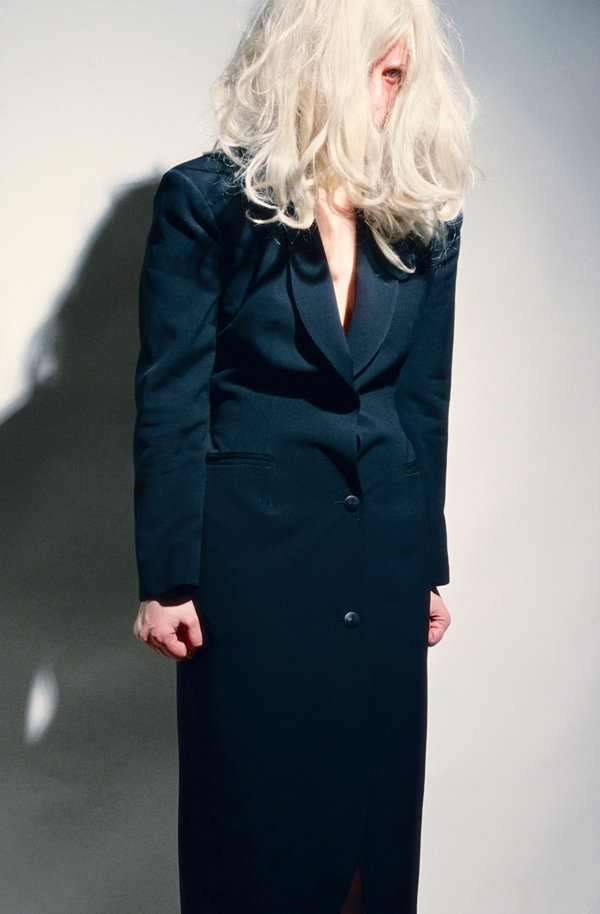Like Robert Mapplethorpe, who has had exhibitions at two LA museums this spring—the J. Paul Getty Museum and the Los Angeles County Museum of Art—Cindy Sherman is a difficult subject because the work is so well known already. The exhibition at The Broad museum does manage a few surprises, however. All but 12 of the 169 pieces in the exhibition are drawn from the Broads’ own collection, which has the largest holdings of Sherman’s work anywhere. Eli and Edye Broad began collecting her photography when they saw an exhibition of it in 1982 at the New York gallery Metro Pictures. In general, the Broad collection contains only the very finest examples of each artist’s work. In general, too, the collection contains very few surprises. But this isn’t the case here, for there is very rare early work by Sherman that I’d never seen exhibited.

Cindy Sherman
Untitled #363, 1976/2000, © Cindy Sherman, Courtesy of the artist and Metro Pictures
Among the early works in this category are examples of three sets of pictures Sherman had made originally in 1975 or 1976 when she was a student in Buffalo, before she went to New York City and began the “Untitled Film Stills” for which she was first celebrated. The most provocative of the three is a set of of 15 titled Untitled. They’re remarkable not only because they’re full-length poses of her as different types that anticipate the “Film Stills” and all else since then, but because of the way she exhibited the work—on a public bus in Buffalo where prints were inserted into the advertising-card slots over the seats. This gesture, preempting commerce in a public setting rather than soaring above such contexts in an art museum, was a stroke of genius of the sort that has misled her admirers into associating her with the postmodernists ever since.
- • •
She was just a naïve young woman who was, like Mapplethorpe, from suburban Long Island, and she was following instincts she’d developed ever since she was a child who’d loved to play dress-up. Yet those instincts led to her close association with postmodernism as soon as she moved to New York. Postmodernism is a theoretical movement, impenetrable to most laymen, from which Sherman has tried to dissociate herself. She denies participation in any of the ideologies of her era. “I’ve never actively thought of my work as feminist or as a political statement,” she has said, adding that the work comes simply from “my observations as a woman in this culture.”[i] On another occasion she tried to preempt all efforts to attribute theoretical intentions to her work, especially postmodernist ones, saying, “I wanted to make something which people could relate to without having to read a book about it first.” [ii]
Nonetheless, the association with postmodernism persists and has become a major distraction from more helpful ways of looking at her art. Out of respect for Sherman’s attempts to dissociate herself from postmodernism, chief curator of the Broad exhibition Philipp Kaiser raises the issue in his catalog essay with somewhat jargonistic caution and circumlocution. “Even though… Sherman gracefully sidesteps theoretical instrumentalization,” he writes, “her work can in a sense be understood as a case study in postmodern theorizing.”[iii] Sherrie Levine is another artist who, like Sherman, is a member of the “Pictures Generation” now in her 60s, was in the 1977 New York exhibition “Pictures,” and shows at Metro Pictures. But Levine also became a true pioneer of postmodernism with her 1981 work “After Walker Evans,” in which she re-photographed Evans prints from reproductions in one of his museum catalogs and presented the results as her own work. The point she was making is the essence of postmodernism because it proposes that in our mass-media age every image conceivable has already been made, so the artist can only “recycle” imagery that already exists.

Cindy Sherman, Untitled #92, 1981,
© Cindy Sherman
Courtesy of the artist and Metro Pictures
Where do I come out in this controversy over postmodernism that always seems, as in Kaiser’s otherwise excellent essay, to distract from appreciation of Sherman’s work on its own terms? I think the confusion results from the fact that Sherman was genuinely inspired by the artistic predecessor whose work did lead to postmodernism: Andy Warhol. He pioneered image recycling when he created paintings in multiples that, for instance, reproduced news photographs of Elizabeth Taylor or Jackie Kennedy and called attention to his mass-media sources by making his re-photographs look dirty in enlargement the way images copied from newspapers always do when blown up. He also tried to collapse any distinction between art and commerce when he called his studio “The Factory.” Sherman even speaks about her work with the same innocence that Warhol always assumed. She has said she wanted to make work that “anybody off the street could appreciate… That’s the reason why I wanted to imitate something out of the culture”; but then she adds, “… and make fun of the culture as I was doing it.”[iv]
- • •
Pioneering postmodernist Richard Prince, who first had an impact in 1980 by photographing Marlboro cowboys in magazine ads and presenting the prints in galleries as his art, has of late been plagued by copyright suits filed on behalf of commercial photographers whose work he rephotographed. Such literal-minded reproduction of other people’s photography is very different from Sherman’s work. At “The Broad” (as the new museum wants to be known), a wall text points out that her “Untitled Film Stills” was created by “taking cues from an array of film characters, though never directly imitating a specific one.” Thus, instead of illustrating a theory of culture, she imbued her work with the ambiguity and paradox that are the essential elements of original art.
On the one hand, the characters she impersonated were movie stars; on the other hand, they were the stars of the black-and-white B-movies she saw on the Late Show when she was a kid. They’re stars, but anonymous ones because they’re mostly forgotten now (or anyway, known only to film-buff fanatics). When she first had the idea of enacting stars, she turned herself into a dead ringer for Lucille Ball, judging by a Photobooth picture she took. But then, in order to make a greater variety of film stills, she decided to go for a more generic star, which is to say an unidentifiable celebrity, one whose fame is unknown. That’s the sort of paradox of which art is made.

Cindy Sherman
Untitled #122, 1983
© Cindy Sherman
Courtesy of the artist and Metro Pictures
Sherman collaborated with the Broad’s curators on the exhibition, which acknowledges in prominent ways that occasionally her photographic references to movies do become specific. The title of the exhibition, “Cindy Sherman: Imitation of Life,” is an allusion to Douglas Sirk’s 1959 movie melodrama, titled Imitation of Life, in which Lana Turner starred as a woman torn between her acting career and the needs of her troubled daughter. And the cover image on the catalog, Untitled #122 (1983), reflects Sherman’s fascination with the real-life career of another Hollywood star, Frances Farmer, whose tragic descent into madness Jessica Lange had portrayed in the movie Frances, which was released in 1982, the year before Sherman made her photograph.

Cindy Sherman
Untitled #97, 1982,
© Cindy Sherman
Courtesy of the artist and Metro Pictures
But by 1981 Sherman had moved beyond allusions to the movies with a new series that plunged her into controversy. These were double-wide horizontal poses looking down at her sprawled, usually, on a floor. The series, called “Centerfolds,” had been commissioned by a magazine, though not by Playboy or some other men’s mag of the sort it parodied. The work was done at the behest of the tony, esoteric journal Artforum, whose editor at the time, feminist Ingrid Sischy, then rejected Sherman’s images. (Full disclosure: I was writing for Artforum in that period, though not on Sherman’s work.) I believe Sherman was startled not only by Sischy’s response but by the negative reaction the series elicited elsewhere. She undid the damage in 1982 by making a new series, upright, of her being decidedly unsexy in a pink bathrobe—images that art critic Peter Schjeldahl felt were “as close as we will ever get to ‘the real Cindy.’ ”[v]
I would say, though, that a response even more indicative of Sherman’s ability to be independent-minded was her acceptance, beginning in 1983, of commissions from Vogue Paris and Harper’s Bazaar. While feminists rejected outright the treatment of women in Playboy, they were even more preoccupied with—and at best ambivalent about—the image of women in such women’s magazines. Rather than just ruing the way these publications depicted women, Sherman was pioneering the effort to change their image of women, and she has continued to do work for such magazines since then. In trying to change these publications, Sherman has played a risky double game, for the magazines have of course been trying to exploit her reputation in a way that defanged it. If there’s any work of hers that exacts some revenge from the magazine culture she has braved, it is her 1997 movie Office Killer in which, as a Broad wall text sums up the plot, “A drab copy editor at Constant Consumer magazine …goes on a killing spree.”
One tactic with which Sherman defended her independence in the ensuing years was to do a series that was not only not publishable in mass-market magazines, but was so salacious she could hardly bear to pose for the pictures herself. In 1988–90, she had done photo parodies of paintings by the old masters for which she donned ever more obviously false masks, hair pieces, and even breasts. At the same time, between 1985 and 1991, she was also posing as women to whom grotesque violence had been done, and from 1986 on she herself was increasingly disappearing from the images, sometimes because the subject depicted has been buried either alive or, in one instance, in her own vomit. Then in 1992 Sherman embarked on a series of “Sex Pictures” employing, again, according to the Broad wall text, “artificial body parts purchased from a medical supply catalog and typically employed for educational purposes.”

Cindy Sherman
Untitled, #571, 2016
© Cindy Sherman
Courtesy of the artist and Metro Pictures
These were works intended to, as another wall text puts it, “challenge the artist’s wide acceptance and success in the art world.” She has succeeded even with her most ardent admirer, Mr. Broad, for none of the “Sex Pictures” are in either the Broad catalog, the exhibition itself, or, presumably, the Broad collection. Not until 2000 did Sherman return in her own visage as the subject of her photographs. Since then she has been posing as a series of matronly women and, in the most recent work, as movie stars of the silent era. There is something quite personal and touching about the fact that, 40 years after beginning her extraordinary career, we find Sherman acting her own age.
Cindy Sherman: Imitation of Life
The Broad Museum, Los Angeles
June 11 – October 2, 2016
endnotes
[i] Quoted in Gabriele Schor, Cindy Sherman: The Early Works, 1975 – 1977 (Ostfildern, Germany: Hatje Cantz & New York: Metro Pictures, 2012), 11. This catalogue raisonné is one of the most informative books that has been done on Sherman, though also one of the least read because it doesn’t fit handily in a tote bag or rest comfortably in the reader’s lap.
[ii] Quoted in Sandy Nairne, State of the Art: Ideas and Images in the 1980s (London: Chatto & Windus, 1987), 132.
[iii] Philipp Kaiser, “Imitation of Life: Appropriation, the Cinematic Impulse, and Beyond” in Cindy Sherman: Imitation of Life (Los Angeles: The Broad & New York: Delmonico Books, 2016), 9. Kaiser’s summary of the theoretical winds with which Sherman’s work has been swept is actually very useful, and at the end of the catalogue his essay is balanced nicely by an interview Sofia Coppola did with Sherman in which the artist is pointedly plain spoken and untheoretical.
[iv] Nairne, 132.
[v] Peter Schjeldahl, “Introduction: The Oracle of Images,” Cindy Sherman (New York: Pantheon Books, 1984), 10.


















0 Comments